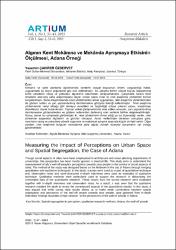Algının Kent Mekanına ve Mekanda Ayrışmaya Etkisinin Ölçülmesi
Künye
ÇAKIRER-ÖZSERVET, Yasemin. “Algının Kent Mekânına ve Mekânda Ayrışmaya Etkisinin Ölçülmesi.” Hasan Kalyoncu Üniversitesi Güzel Sanatlar ve Tasarım Fakültesi Dergisi, 1.1 (2013): 33-43.Özet
Mimarlık ve şehir planlama eğitimlerinde kentlerin sosyal boyutunun önemi vurgulandığı halde, uygulamada bu boyut çoğunlukla göz ardı edilmektedir. Bu çalışma kentin sosyal boyutu kapsamında kentli varsılların varoş ve yoksulluk algılarının ölçülmesini amaçlamaktadır. Çalışmada Adana kenti örneklem alanında saha araştırmasına dayalı olmak üzere nicel ve nitel araştırma yöntemleri birlikte kurgulanmıştır. Saha araştırmasında nicel yöntemlerden anket uygulaması, nitel araştırma yöntemlerinden
de gözlem notları ve yarı yapılandırılmış derinlemesine görüşme tekniği kullanılmıştır. Nitel araştırma yöntemlerinin veriyi olduğu gibi saklayıp sunabilen ve özgünlüğü ortaya çıkaran yapısı, araştırmayı destekleyici olarak kullanılmıştır. Yapılan anket görüşmelerinde elde edilen sonuçlar, yarı yapılandırılmış derinlemesine görüşmelerden ve gözlem notlarından derlenmiş olan verilerle birlikte değerlendirilmiştir. Sonuç olarak bu çalışmada görülmüştür ki, nicel yöntemlerin ihmal ettiği ya da ölçemediği veriler, nitel yöntemler sayesinde ölçülebilir ve görünür olmuştur. Anket verilerinden derlenen sonuçlara göre, varsılların varoş ve yoksullara yönelik algısında ve mekânsal ayrışma arasında küçük bir ilişki vardır. Diğer yandan, nitel araştırma bulguları sonuçlarına göre algıda yüksek düzeyde ayrışmanın var olduğu görülmektedir.
Though social aspects of cities have been emphasized in architecture and urban planning departments of universities, this perspective has been mostly ignored in practical life. This study aims to understand the measurement of city’s well-off people’s perceptions towards poor people in the context of social aspects of cities. The method of the study was designed based on the fieldwork in the city of Adana through merging quantitative and qualitative techniques. In the study, surveys were used as a part of quantitative technique and, observation notes and semi-structured in-depth interviews were used as examples of qualitative technique. Qualitative methods were particularly used to support the research in elaborating the unrevealed data of the quantitative research. These results from the survey research were evaluated together with in-depth interviews and observation notes. As a result, it was seen that the qualitative research enabled the study to reveal the unmeasured aspects of the quantitative results. In this study, it was argued that while survey data results allows us to make weak connections between spatial segregation and perception of the well-off people towards poor people, data gathered from in-depth interviews’ findings illustrates a high variation in the perceptions of the well-off people in Adana.
Bağlantı
https://hdl.handle.net/11352/539Koleksiyonlar
- Mimarlık Bölümü [152]



















